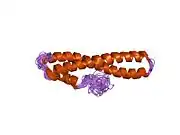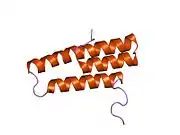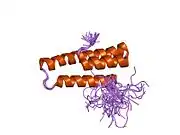LDL-receptor-related protein-associated protein
Low density lipoprotein receptor-related protein-associated protein 1 also known as LRPAP1 or RAP is a chaperone protein which in humans is encoded by the LRPAP1 gene.[5][6]
| Alpha-2-MRAP_N | |||||||||
|---|---|---|---|---|---|---|---|---|---|
 haddock model of the complex between double module of lrp, cr56, and first domain of receptor associated protein, rap-d1. | |||||||||
| Identifiers | |||||||||
| Symbol | Alpha-2-MRAP_N | ||||||||
| Pfam | PF06400 | ||||||||
| InterPro | IPR009066 | ||||||||
| SCOP2 | 1lre / SCOPe / SUPFAM | ||||||||
| |||||||||
| Alpha-2-MRAP_C | |||||||||
|---|---|---|---|---|---|---|---|---|---|
 solution structure of domain 3 of rap | |||||||||
| Identifiers | |||||||||
| Symbol | Alpha-2-MRAP_C | ||||||||
| Pfam | PF06401 | ||||||||
| InterPro | IPR010483 | ||||||||
| |||||||||
Function
LRPAP1 is involved with trafficking of certain members of the LDL receptor family including LRP1 and LRP2.[7] It is a glycoprotein that binds to the alpha-2-macroglobulin receptor, as well as to other members of the low density lipoprotein receptor family. It acts to inhibit the binding of all known ligands for these receptors, and may prevent receptor aggregation and degradation in the endoplasmic reticulum, thereby acting as a molecular chaperone.[8] It may be under the regulatory control of calmodulin, since it is able to bind calmodulin and be phosphorylated by calmodulin-dependent kinase II.
Interactions
LDL-receptor-related protein-associated protein has been shown to interact with LRP2.[9][10]
Mutations and diseases related to LRPAP1
Lipid metabolizing proteins may elevate susceptibility to dementia leading to differences in genetic makeup.[11] PCR-restriction fragment length polymorphism technique is used for genotyping of LRPAP1 intron 5 insertion/deletion.[11] The studies suggested that DD genotype and *D allele of LRPAP gene showed increased frequency for degenerative dementias on comparison with the control group and that LRPAP1-D allele remarkably increases the vulnerability to degenerative dementias.[11] On genotyping of LRPAP1 polymorphism is observed because of 37 base pair insertion in intron 5.[11] Also insertion allele being larger than deletion allele makes possible in detecting difference by gel electrophoresis.[12] Suppression of receptor-binding domain of LRP LDLR is due to overexpression of LRPAP (the protein product of LRPAP gene).[13] LRP gives protection across LDL by LRPAP and its downregulation may be subjected for an elevation of LDL and Ab-related neuronal toxicity as LRP supports in binding of ligand and internalization of LRP ligands like apo-E-enriched LDL cholesterol and Ab protein.[11] Insertion/deletion is an intronic polymorphism of LRPAP gene, Influencing DD genotype and D allele for the synthesis of LRPAP protein can be lrp-mediated mechanism contributing to dementia.[11] Concern for developing sensitivity for dementia is because of several shared common genetic platforms and DD genotype or D allele of LRPAP gene may be one such.[11] So on 37-bp insertion/deletion that was studied as an intronic polymorphism, it could be having an unintended pursuit for lipid receptor protein by regulation of LRPAP expression, or it could be in linkage disequilibrium in addition to other biologically relevant polymorphism in the LRPAP1 or an adjacent gene in chromosome 4.[14] Results being consistent with earlier study where the authors have endowed deletion allele frequency clearly high in late-onset Alzheimer’s disease patients on comparison with non-demented aged controls.[14]
Mendelian forms of myopia has been identified in four consanguineous families and are the likely causal mutations implementing exome /autozygome investigated to recognize homozygous truncating variants in LRPAP1.[15] Influencing TGF-β activity, chaperone of LRP1 is encoded by LRPAP1.Notably salient deficiency of LRP1 and upregulation of TGF-β in affected individuals cells, the known data being consistent on the importance of TGF-β in remodeling for the sclera of myopia and the increased frequency in individuals for myopia having Marfan syndrome which has characteristics of upregulated TGF-β signaling.[16] Analysizing the absence of the normal protein was done with immunoblot for affected individuals having LRPAP1 mutations revealing the mutations in LRPAP1 probability of loss-of-function mutations.[15] Encoding (Low Density Lipoprotein Receptor-Related Protein Associated protein 1) LRPAP is a largely expressed gene, and a 357 amino acid protein thought as a chaperone binding and protecting the lipoproteins receptor-related proteins LRP1 and LRP2.[17][18] A model suggested by a study wherein LRPAP1 leading to deficiency of LRP1 which was responsible to perturbation of TGF-β regulation and might cause abnormal ECM remodeling in the eye development.[15] On observation for increasing axial length was one of the salient features of Marfan syndrome also resulting in TGF-β supported the model.[19][20] Therefore, individuals having myopia responding to therapeutic strategy initiated before ECM remodeling could be considered as an approach for individuals with LRPAP1 related myopia.[15]
References
- GRCh38: Ensembl release 89: ENSG00000163956 - Ensembl, May 2017
- GRCm38: Ensembl release 89: ENSMUSG00000029103 - Ensembl, May 2017
- "Human PubMed Reference:". National Center for Biotechnology Information, U.S. National Library of Medicine.
- "Mouse PubMed Reference:". National Center for Biotechnology Information, U.S. National Library of Medicine.
- Strickland DK, Ashcom JD, Williams S, Battey F, Behre E, McTigue K, Battey JF, Argraves WS (Jul 1991). "Primary structure of alpha 2-macroglobulin receptor-associated protein. Human homologue of a Heymann nephritis antigen". The Journal of Biological Chemistry. 266 (20): 13364–9. doi:10.1016/S0021-9258(18)98848-4. PMID 1712782.
- Korenberg JR, Argraves KM, Chen XN, Tran H, Strickland DK, Argraves WS (Jul 1994). "Chromosomal localization of human genes for the LDL receptor family member glycoprotein 330 (LRP2) and its associated protein RAP (LRPAP1)". Genomics. 22 (1): 88–93. doi:10.1006/geno.1994.1348. PMID 7959795.
- "Entrez Gene: LRPAP1 low density lipoprotein receptor-related protein associated protein 1".
- Nielsen PR, Ellgaard L, Etzerodt M, Thogersen HC, Poulsen FM (Jul 1997). "The solution structure of the N-terminal domain of alpha2-macroglobulin receptor-associated protein". Proceedings of the National Academy of Sciences of the United States of America. 94 (14): 7521–5. Bibcode:1997PNAS...94.7521N. doi:10.1073/pnas.94.14.7521. PMC 23854. PMID 9207124.
- Lou X, McQuistan T, Orlando RA, Farquhar MG (Apr 2002). "GAIP, GIPC and Galphai3 are concentrated in endocytic compartments of proximal tubule cells: putative role in regulating megalin's function". Journal of the American Society of Nephrology. 13 (4): 918–27. doi:10.1681/ASN.V134918. PMID 11912251.
- Orlando RA, Farquhar MG (Apr 1994). "Functional domains of the receptor-associated protein (RAP)". Proceedings of the National Academy of Sciences of the United States of America. 91 (8): 3161–5. Bibcode:1994PNAS...91.3161O. doi:10.1073/pnas.91.8.3161. PMC 43535. PMID 7512726.
- Pandey P, Pradhan S, Mittal B (2008). "LRP-associated protein gene (LRPAP1) and susceptibility to degenerative dementia". Genes, Brain and Behavior. 7 (8): 943–950. doi:10.1111/j.1601-183X.2008.00436.x. PMID 18721259. S2CID 19207648.
- Pandey P, Pradhan S, Mittal B (2008). "LRP-associated protein gene (LRPAP1) and susceptibility to degenerative dementia". Genes, Brain and Behavior. 7 (8): 943–50. doi:10.1111/j.1601-183X.2008.00436.x. PMID 18721259. S2CID 19207648.
- Willnow TE, Sheng Z, Ishibashi S, Herz J (1994). "Inhibition of hepatic chylomicron remnant uptake by gene transfer of a receptor antagonist". Science. 264 (5164): 1471–4. Bibcode:1994Sci...264.1471W. doi:10.1126/science.7515194. PMID 7515194.
- Sánchez L, Alvarez V, González P, González I, Alvarez R, Coto E (2001). "Variation in the LRP-associated protein gene (LRPAP1) is associated with late-onset Alzheimer disease". American Journal of Medical Genetics. 105 (1): 76–8. doi:10.1002/1096-8628(20010108)105:1<76::aid-ajmg1066>3.3.co;2-i. PMID 11425005.
- Aldahmesh MA, Khan AO, Alkuraya H, Adly N, Anazi S, Al-Saleh AA, Mohamed JY, Hijazi H, Prabakaran S, Tacke M, Al-Khrashi A, Hashem M, Reinheckel T, Assiri A, Alkuraya FS (2013-08-08). "Mutations in LRPAP1 Are Associated with Severe Myopia in Humans". Am J Hum Genet. 93 (2): 313–20. doi:10.1016/j.ajhg.2013.06.002. PMC 3738831. PMID 23830514.
- Aldahmesh MA, Khan AO, Alkuraya H, Adly N, Anazi S, Al-Saleh AA, Mohamed JY, Hijazi H, Prabakaran S, Tacke M, Al-Khrashi A, Hashem M, Reinheckel T, Assiri A, Alkuraya FS (2013). "Mutations in LRPAP1 are associated with severe myopia in humans". American Journal of Human Genetics. 93 (2): 313–20. doi:10.1016/j.ajhg.2013.06.002. PMC 3738831. PMID 23830514.
- Willnow TE, Armstrong SA, Hammer RE, Herz J (1995). "Functional expression of low density lipoprotein receptor-related protein is controlled by receptor-associated protein in vivo". Proceedings of the National Academy of Sciences of the United States of America. 92 (10): 4537–41. Bibcode:1995PNAS...92.4537W. doi:10.1073/pnas.92.10.4537. PMC 41979. PMID 7538675.
- Willnow TE, Rohlmann A, Horton J, Otani H, Braun JR, Hammer RE, Herz J (1996). "RAP, a specialized chaperone, prevents ligand-induced ER retention and degradation of LDL receptor-related endocytic receptors". The EMBO Journal. 15 (11): 2632–9. doi:10.1002/j.1460-2075.1996.tb00623.x. PMC 450198. PMID 8654360.
- Loeys BL, Dietz HC, Braverman AC, Callewaert BL, De Backer J, Devereux RB, Hilhorst-Hofstee Y, Jondeau G, Faivre L, Milewicz DM, Pyeritz RE, Sponseller PD, Wordsworth P, De Paepe AM (2010). "The revised Ghent nosology for the Marfan syndrome". Journal of Medical Genetics. 47 (7): 476–85. doi:10.1136/jmg.2009.072785. hdl:1854/LU-1013955. PMID 20591885. S2CID 13895128.
- Brooke BS, Habashi JP, Judge DP, Patel N, Loeys B, Dietz HC (2008). "Angiotensin II blockade and aortic-root dilation in Marfan's syndrome". The New England Journal of Medicine. 358 (26): 2787–95. doi:10.1056/NEJMoa0706585. PMC 2692965. PMID 18579813.
Further reading
- Carter CJ (2007). "Convergence of genes implicated in Alzheimer's disease on the cerebral cholesterol shuttle: APP, cholesterol, lipoproteins, and atherosclerosis". Neurochemistry International. 50 (1): 12–38. doi:10.1016/j.neuint.2006.07.007. PMID 16973241. S2CID 33569371.
- Williams SE, Ashcom JD, Argraves WS, Strickland DK (May 1992). "A novel mechanism for controlling the activity of alpha 2-macroglobulin receptor/low density lipoprotein receptor-related protein. Multiple regulatory sites for 39-kDa receptor-associated protein". The Journal of Biological Chemistry. 267 (13): 9035–40. doi:10.1016/S0021-9258(19)50384-2. PMID 1374383.
- Kounnas MZ, Argraves WS, Strickland DK (Oct 1992). "The 39-kDa receptor-associated protein interacts with two members of the low density lipoprotein receptor family, alpha 2-macroglobulin receptor and glycoprotein 330". The Journal of Biological Chemistry. 267 (29): 21162–6. doi:10.1016/S0021-9258(19)36811-5. PMID 1400426.
- Strickland DK, Ashcom JD, Williams S, Battey F, Behre E, McTigue K, Battey JF, Argraves WS (Jul 1991). "Primary structure of alpha 2-macroglobulin receptor-associated protein. Human homologue of a Heymann nephritis antigen". The Journal of Biological Chemistry. 266 (20): 13364–9. doi:10.1016/S0021-9258(18)98848-4. PMID 1712782.
- Herz J, Goldstein JL, Strickland DK, Ho YK, Brown MS (Nov 1991). "39-kDa protein modulates binding of ligands to low density lipoprotein receptor-related protein/alpha 2-macroglobulin receptor". The Journal of Biological Chemistry. 266 (31): 21232–8. doi:10.1016/S0021-9258(18)54845-6. PMID 1718973.
- Furukawa T, Ozawa M, Huang RP, Muramatsu T (Aug 1990). "A heparin binding protein whose expression increases during differentiation of embryonal carcinoma cells to parietal endoderm cells: cDNA cloning and sequence analysis". Journal of Biochemistry. 108 (2): 297–302. CiteSeerX 10.1.1.1025.9536. doi:10.1093/oxfordjournals.jbchem.a123197. PMID 2229028.
- Herz J, Hamann U, Rogne S, Myklebost O, Gausepohl H, Stanley KK (Dec 1988). "Surface location and high affinity for calcium of a 500-kd liver membrane protein closely related to the LDL-receptor suggest a physiological role as lipoprotein receptor". The EMBO Journal. 7 (13): 4119–27. doi:10.1002/j.1460-2075.1988.tb03306.x. PMC 455121. PMID 3266596.
- Zheng G, Bachinsky DR, Stamenkovic I, Strickland DK, Brown D, Andres G, McCluskey RT (Apr 1994). "Organ distribution in rats of two members of the low-density lipoprotein receptor gene family, gp330 and LRP/alpha 2MR, and the receptor-associated protein (RAP)". The Journal of Histochemistry and Cytochemistry. 42 (4): 531–42. doi:10.1177/42.4.7510321. PMID 7510321.
- Orlando RA, Farquhar MG (Apr 1994). "Functional domains of the receptor-associated protein (RAP)". Proceedings of the National Academy of Sciences of the United States of America. 91 (8): 3161–5. Bibcode:1994PNAS...91.3161O. doi:10.1073/pnas.91.8.3161. PMC 43535. PMID 7512726.
- Jou YS, Goold RD, Myers RM (Nov 1994). "Localization of the alpha 2-macroglobulin receptor-associated protein 1 gene (LRPAP1) and other gene fragments to human chromosome 4p16.3 by direct cDNA selection". Genomics. 24 (2): 410–3. doi:10.1006/geno.1994.1643. PMID 7535288.
- Argraves KM, Battey FD, MacCalman CD, McCrae KR, Gåfvels M, Kozarsky KF, Chappell DA, Strauss JF, Strickland DK (Nov 1995). "The very low density lipoprotein receptor mediates the cellular catabolism of lipoprotein lipase and urokinase-plasminogen activator inhibitor type I complexes". The Journal of Biological Chemistry. 270 (44): 26550–7. doi:10.1074/jbc.270.44.26550. PMID 7592875.
- Bu G, Geuze HJ, Strous GJ, Schwartz AL (May 1995). "39 kDa receptor-associated protein is an ER resident protein and molecular chaperone for LDL receptor-related protein". The EMBO Journal. 14 (10): 2269–80. doi:10.1002/j.1460-2075.1995.tb07221.x. PMC 398334. PMID 7774585.
- Van Leuven F, Hilliker C, Serneels L, Umans L, Overbergh L, De Strooper B, Fryns JP, Van den Berghe H (Jan 1995). "Cloning, characterization, and chromosomal localization to 4p16 of the human gene (LRPAP1) coding for the alpha 2-macroglobulin receptor-associated protein and structural comparison with the murine gene coding for the 44-kDa heparin-binding protein". Genomics. 25 (2): 492–500. doi:10.1016/0888-7543(95)80050-V. PMID 7789983.
- Medh JD, Fry GL, Bowen SL, Pladet MW, Strickland DK, Chappell DA (Jan 1995). "The 39-kDa receptor-associated protein modulates lipoprotein catabolism by binding to LDL receptors". The Journal of Biological Chemistry. 270 (2): 536–40. doi:10.1074/jbc.270.2.536. PMID 7822276.
- Korenberg JR, Argraves KM, Chen XN, Tran H, Strickland DK, Argraves WS (Jul 1994). "Chromosomal localization of human genes for the LDL receptor family member glycoprotein 330 (LRP2) and its associated protein RAP (LRPAP1)". Genomics. 22 (1): 88–93. doi:10.1006/geno.1994.1348. PMID 7959795.
- Maruyama K, Sugano S (Jan 1994). "Oligo-capping: a simple method to replace the cap structure of eukaryotic mRNAs with oligoribonucleotides". Gene. 138 (1–2): 171–4. doi:10.1016/0378-1119(94)90802-8. PMID 8125298.
- Willnow TE, Rohlmann A, Horton J, Otani H, Braun JR, Hammer RE, Herz J (Jun 1996). "RAP, a specialized chaperone, prevents ligand-induced ER retention and degradation of LDL receptor-related endocytic receptors". The EMBO Journal. 15 (11): 2632–9. doi:10.1002/j.1460-2075.1996.tb00623.x. PMC 450198. PMID 8654360.
- Jacobsen L, Madsen P, Moestrup SK, Lund AH, Tommerup N, Nykjaer A, Sottrup-Jensen L, Gliemann J, Petersen CM (Dec 1996). "Molecular characterization of a novel human hybrid-type receptor that binds the alpha2-macroglobulin receptor-associated protein". The Journal of Biological Chemistry. 271 (49): 31379–83. doi:10.1074/jbc.271.49.31379. PMID 8940146.
- Bu G, Rennke S, Geuze HJ (Jan 1997). "ERD2 proteins mediate ER retention of the HNEL signal of LRP's receptor-associated protein (RAP)". Journal of Cell Science. 110. 110 (1): 65–73. doi:10.1242/jcs.110.1.65. PMID 9010785.
- Petersen CM, Nielsen MS, Nykjaer A, Jacobsen L, Tommerup N, Rasmussen HH, Roigaard H, Gliemann J, Madsen P, Moestrup SK (Feb 1997). "Molecular identification of a novel candidate sorting receptor purified from human brain by receptor-associated protein affinity chromatography". The Journal of Biological Chemistry. 272 (6): 3599–605. doi:10.1074/jbc.272.6.3599. PMID 9013611.
- Nielsen PR, Ellgaard L, Etzerodt M, Thogersen HC, Poulsen FM (Jul 1997). "The solution structure of the N-terminal domain of alpha2-macroglobulin receptor-associated protein". Proceedings of the National Academy of Sciences of the United States of America. 94 (14): 7521–5. Bibcode:1997PNAS...94.7521N. doi:10.1073/pnas.94.14.7521. PMC 23854. PMID 9207124.
External links
- LDL-Receptor+Related+Protein-Associated+Protein at the U.S. National Library of Medicine Medical Subject Headings (MeSH)











